The post Chinese Kung Fu Master on IShowSpeed: “He Really Loves Kung Fu” first appeared on China Academy.
]]>
Over the weekend, Chinese internet was abuzz with one unexpected storyline—American YouTuber IShowSpeed’s kung fu pilgrimage to the Shaolin Temple in Henan, China. For many Chinese viewers, the live broadcast felt straight out of a classic martial arts film.
At the start of the stream, Speed donned a monk-style headpiece and excitedly told viewers that his goal for the day was to find a real kung fu master and begin training at the world-famous Shaolin Temple. Longtime fans know Speed has a soft spot for Chinese martial arts—in fact, one of his viral clips online shows him reacting enthusiastically to a Chinese Kung Fu film Shaolin Soccer.

But the journey didn’t exactly begin smoothly. Speed first wandered into a temple, shirtless and full of energy, where he bowed and burned incense in front of a so-called master. Chinese viewers couldn’t help but laugh, joking that he had stumbled into “Little Leiyin Temple”—a trap temple from Journey to the West, used to deceive the Monkey King. Many online noted that this temple was a tourist attraction with little to do with authentic kung fu training.

For the next two hours, Speed roamed the vast Shaolin complex, searching in vain for a true teacher. His team seemed disorganized and unsure where to go. At one point, Speed sat silently in the car, visibly disheartened. “I just wanna learn something real,” he mumbled. When fans tried to cheer him up with gifts, he was far from his usual high-energy self. As one viewer put it, “At that moment, Speed looked like a lost child.”

Then came a dramatic turning point—Speed unexpectedly met a kung fu coach with the surname Liang, who agreed to teach him. What followed became one of the most widely shared video moments on Chinese and international social media: Speed, under Master Liang’s guidance, practicing real Shaolin Kung Fu with impressive focus. They were later joined by a group of local kids, training together in picture-perfect form.
In one now-iconic scene, when Speed was struck on the arm and back with a wooden staff and collapsed to the ground in pain, Master Liang rushed over, lifting his new student with care, and delivered a line that instantly went viral:
“It’s pain, it’s life. It’s pain, it’s Shaolin. It’s pain, it’s Kung Fu. It’s pain, it’s you.”

One viewer on Zhihu, often referred to China’s Quora summed up the stream as “a real-life greatest hits of every kung fu movie ever made: the fake master, the eager student, the betrayal, the dead ends, the deceptive guides, the language barrier, and finally—the real master, with true skill and humility.”
Another wrote: “This livestream felt accidentally perfect. The first half was a mess—he couldn’t find a master, stumbled into a tourist trap, learned a bunch of fake moves, wandered aimlessly around the temple. He looked like he was about to cry. And then boom—Master Liang shows up. He speaks English, knows multiple styles, teaches everything from hard qigong to nunchaku to drunken boxing. By the end, I felt like I had learned kung fu just by watching. All the chaos earlier just made the ending feel like a reward.”
Master Liang’s humble demeanor, clear skill, and deep respect for Shaolin culture quickly earned him praise from viewers worldwide. Many commented that “he saved the stream,” and some even began referring to him as “a true master.”
The day after the livestream, Master Liang went live himself, sharing his side of the story and answering curious viewers’ questions. “I’m Liang Xiaolong,” he said. “I work at the Shaolin Temple Wushu Training Center. My job is to introduce and demonstrate Shaolin kung fu and culture to enthusiasts and tourists from around the world.”
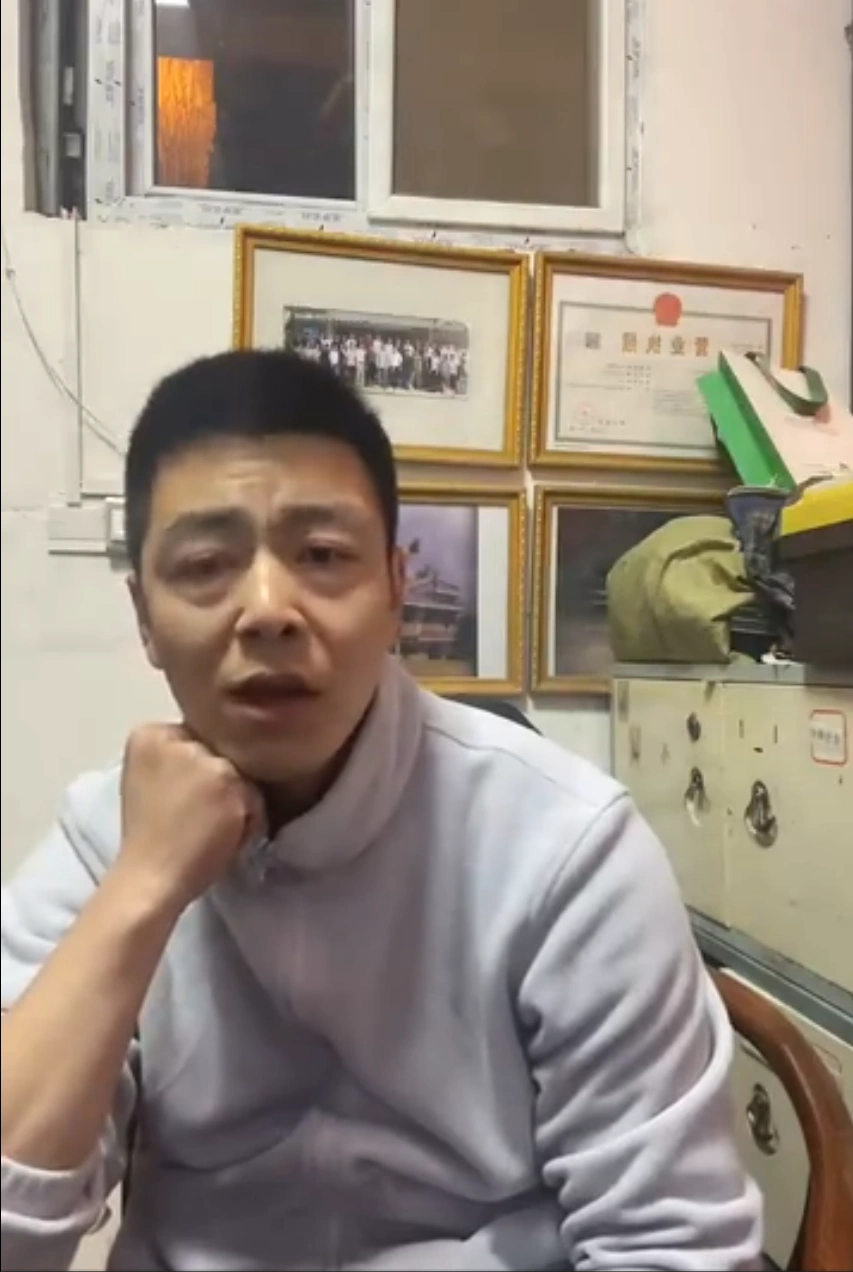 On March 29, Master Liang started a brief livestream on Chinese social media.
On March 29, Master Liang started a brief livestream on Chinese social media.
Naturally, most viewers wanted to know more about his sudden encounter with Speed. “I didn’t know speed at first,” Master Liang admitted. Clearly, he had no idea that the guy who just showed up and bowed to him had over 30 million followers online.
Though their time together was short, Liang had high praise for Speed: “Once I met him, I thought—what a great guy. He’s hardworking, driven, and takes things seriously. I could tell he had his own understanding of kung fu.” He also talked about Speed’s build: “He’s really strong—solid muscles all around.”
When asked if he believed Speed truly loved kung fu, Master Liang responded without hesitation: “I do think he genuinely likes kung fu. You can tell a lot through someone’s eyes—during the stream, I looked at his eyes and they really stood out. There was something there.” And as for the experience itself? “Honestly, I think I made a real friend through this livestream,” he said
Despite his rising popularity, Master Liang stayed humble. When asked whether he could defeat Speed’s bodyguard, he laughed: “No way. Not a chance. And even if we were in the same weight class, I probably still couldn’t take him. Those guys have professional combat training.”
Viewers also asked if he’d consider teaching kung fu online. Liang happily agreed: “If people want to learn, I’d be thrilled to share.”
After nearly 40 minutes of livestreaming, and with fans still flooding him with questions, Master Liang politely wrapped up: “It’s late, and I’ve got work tomorrow. Everyone, get some rest, sleep early.” A few minutes later, he added with a smile: “Okay friends, I’ve already gone three minutes over. I really gotta go now.”
Since then, Master Liang has kept his word—occasionally livestreaming on Chinese platforms, teaching students the same moves he demonstrated to Speed. Calm, focused, and humble, he remains the same “real master” that viewers fell in love with during that unforgettable stream. Just like at the end of the livestream, Speed tried to offer him money as thanks. But Master Liang simply smiled and replied: “Chinese and American people are friends. Friends don’t need money between them. If you insist, maybe buy some candy for the kids.”
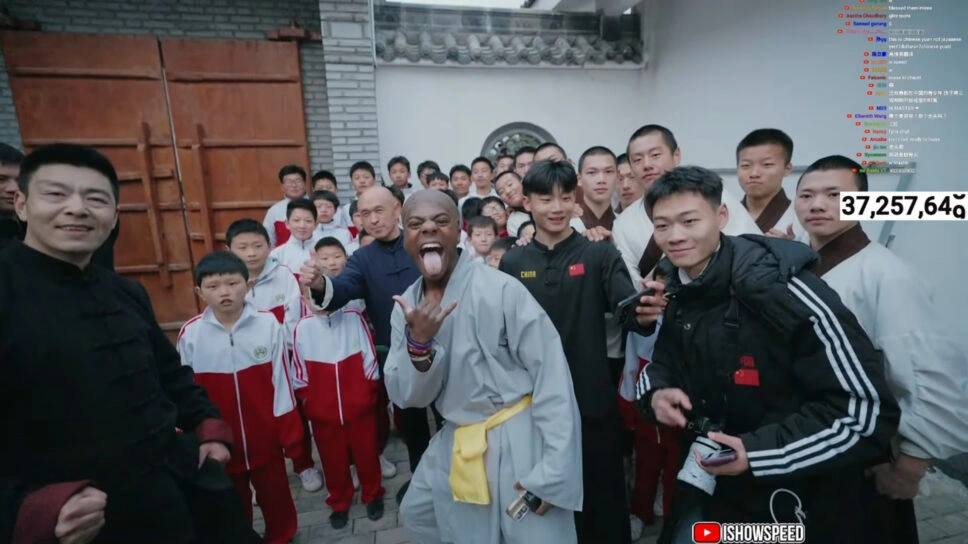 Speed took a photo with Master Liang and his students.
Speed took a photo with Master Liang and his students.
The post Chinese Kung Fu Master on IShowSpeed: “He Really Loves Kung Fu” first appeared on China Academy.
]]>The post I Didn’t Expect Canada to Be This Ridiculous About Drug Crime first appeared on China Academy.
]]> A man holding a Canadian Flag with a marijuana leaf celebrated legalization of Cannabis in Canada.
A man holding a Canadian Flag with a marijuana leaf celebrated legalization of Cannabis in Canada.
The news that China had sentenced four Canadian drug traffickers to death quickly climbed to the top of trending on Chinese social media, where thousands of netizens posted messages thanking their police. However, some Western media outlets shifted the focus, suggesting that human rights should take precedence over national sovereignty.
This isn’t the first time Western media has taken such a stance. Back in 2019, Canadian citizen Robert Schellenberg was sentenced to death in China for smuggling 222 kilograms of crystal meth. The verdict sparked an outcry from Western media, with claims that China’s judicial process lacked transparency.
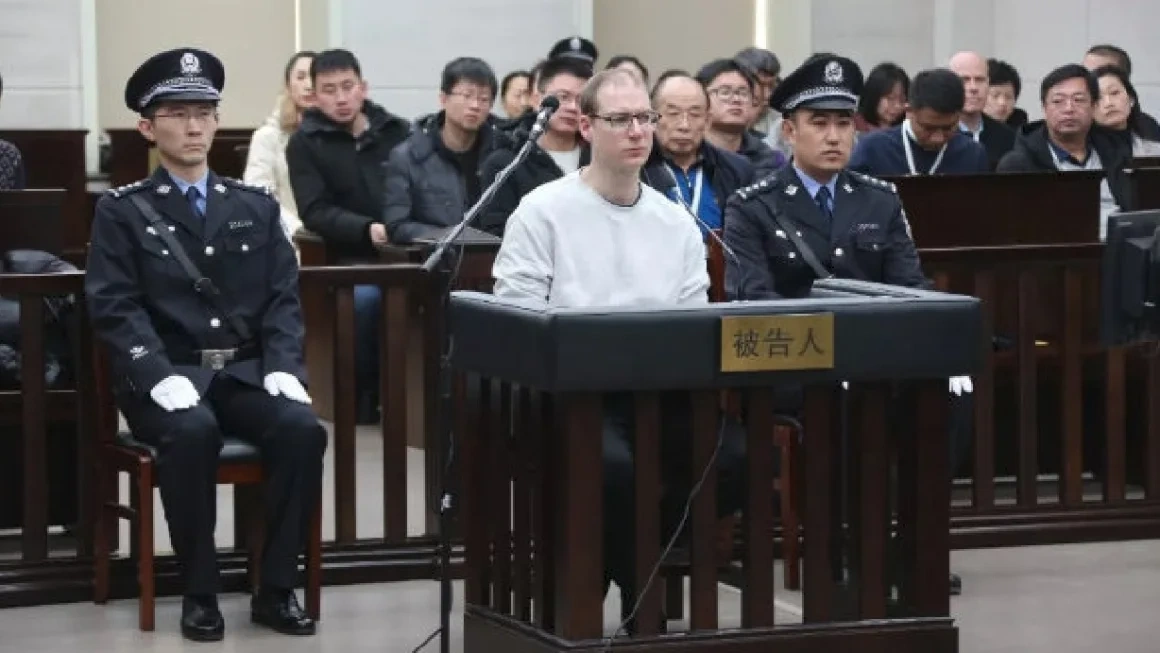 Canadian Robert Lloyd Schellenberg was convicted of drug smuggling in China in 2018.
Canadian Robert Lloyd Schellenberg was convicted of drug smuggling in China in 2018.
Six years later, China’s decision to sentence four more Canadian drug dealers to death has once again drawn criticism from Ottawa. The Canadian government protested the move. In response, Chinese Foreign Ministry spokesperson Mao Ning highlighted that cracking down on drug crimes is a shared responsibility of all countries. She also stated that China applies its legal standards equally to all defendants, regardless of nationality.
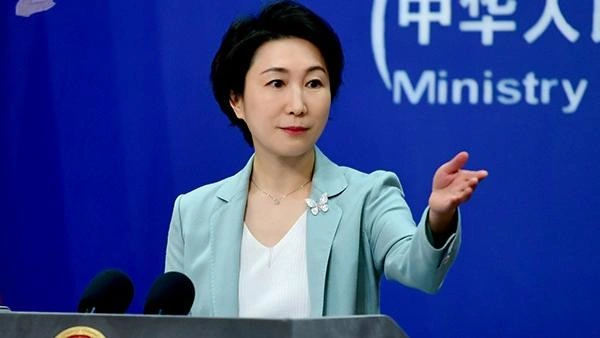 Chinese Foreign Ministry spokesperson Mao Ning
Chinese Foreign Ministry spokesperson Mao Ning
China has long maintained a tough stance on drug smuggling. In 2023 alone, Chinese courts concluded 109,000 drug-related cases. Between 2017 and 2021, 33 anti-narcotics police lost their lives in the line of duty.
The devastating impact of drugs is a reality that most countries around the world are already grappling with. According to United Nations data, hundreds of thousands of people die from drug-related causes every year. Since Canada legalized marijuana in 2018, drug-related crime has surged by 34%. And yet, despite the acknowledged dangers of drug abuse, cases involving Western nationals are often politicized—sometimes to the extent that human rights are argued to trump a country’s legal authority.
Some Western media argue that capital punishment is a violation of human rights. By that logic, it’s akin to claiming kitchens shouldn’t have knives. China’s harsh penalties for drug crimes are deeply rooted in its long and painful history with narcotics, which cost countless lives. In fact, thanks to stringent law enforcement, both the number of drug-related cases and the number of defendants in China have been on the decline for eight consecutive years since peaking in 2015.
 Chinese police seized three tonnes of the drug crystal methamphetamine
Chinese police seized three tonnes of the drug crystal methamphetamine
In contrast, Canada’s drug problem has worsened since the legalization of marijuana. According to data from Addiction Help, 60% of illicit drug users in Canada are between the ages of 15 and 24.
Canadian Foreign Minister Mélanie Joly stated that the four executed individuals held dual citizenship, adding that Ottawa would seek clemency for other Canadians facing similar fates. However, Chinese law does not recognize dual nationality. Furthermore, China applies a consistent legal standard to all foreign nationals involved in drug crimes. According to the country’s case law database, 36 foreign drug traffickers have been sentenced to death over the past five years.
In 2018, the Canadian government, citing a request from the United States, arbitrarily detained Huawei’s Chief Financial Officer Meng Wanzhou, a move that sparked a series of political and judicial disputes between the two countries. Canada’s recent alignment with U.S. tariff hikes on Chinese goods has further strained bilateral ties. In 2024, Ottawa imposed tariffs of 100% on Chinese electric vehicles and 25% on Chinese steel and aluminum products. In response, China launched an anti-discrimination investigation, targeting Canadian exports such as canola oil and seafood—striking at the heart of Canada’s trade with China. This combination of economic confrontation and judicial tension has plunged China-Canada relations into a stalemate across political, economic, and legal domains.
In fact, China’s latest death penalty ruling sets an example for the global legal community. If Western media continues to twist China’s justice system, they might first need to consider three simple questions: What if those 222 kilograms of drugs had ended up in an elementary school in Vancouver? What if the traffickers had laundered money through the dark web using Bitcoin? And what if the victims were their own children?
The post I Didn’t Expect Canada to Be This Ridiculous About Drug Crime first appeared on China Academy.
]]>The post After Using Rednote, TikTok Refugees Flock to China first appeared on China Academy.
]]>Just last weekend, the Brecken family from Mississippi, USA, arrived in Shanghai and met their good friends “啊tiu” (Rednote username) whom they had met on Rednote, capturing a truly precious “century-old photo”.
In the photo, everyone’s faces were filled with happy smiles, as if they were born to play together harmoniously.

Their acquaintance stemmed from a romantic accident. Earlier this year, facing a crisis of closure, Brecken heard from other bloggers that Rednote was “a good opportunity to access the real lives of ordinary Chinese people,” so he curiously registered and posted the latest photo from his phone.
The photo of the father holding his daughter was quickly pushed in front of millions of families. Without prior arrangement, they opened their albums, selected family photos, uploaded them to the comments section, and greeted friends from across the ocean.
The most liked among them was the photo of the “啊tiu” family of three, along with the most classic “Hello”.
Later, this Rednote note screenshot was reposted on X with the caption “Isn’t this just how the world supposed to be?” The post garnered nearly 8 million views and topped the X hot list.
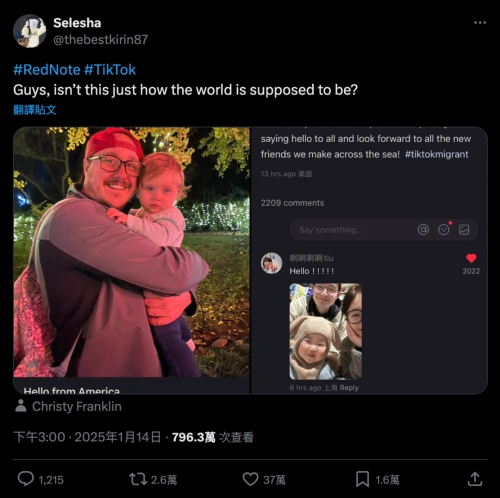
The owners of the two photos contacted each other immediately. The four parents created a group chat and enthusiastically chatted in the group every day, from sharing small food tips to practical parenting experiences. The more they talked, the more they regretted not meeting earlier, even though they did not speak the same language.
In the past, Brecken had very limited knowledge of China, thinking of it as a mysterious ancient country with the Great Wall and temples. His wife had never left Mississippi before and knew little about distant lands.
The communication with “啊tiu” parents and more sharing on Rednote showed them a more charming and authentic side of China, making them yearn more for this land.
In March, they finally set off to meet their distant friends and to see present-day China. Before departing, he eagerly went to trim his hair and beard, packed his bags and gifts, and excitedly counted down on Rednote.

At the crowded Pudong Airport arrival gate, they waved vigorously, embraced with laughter, and exchanged gifts. The American guests crossed the ocean, bringing shiny sea turtle plush toys, custom sweaters with “Let’s be friends” printed on them; while the Chinese hosts reciprocated with seasonal flowers, freshly made Qingtuan, and a few heartfelt tokens.
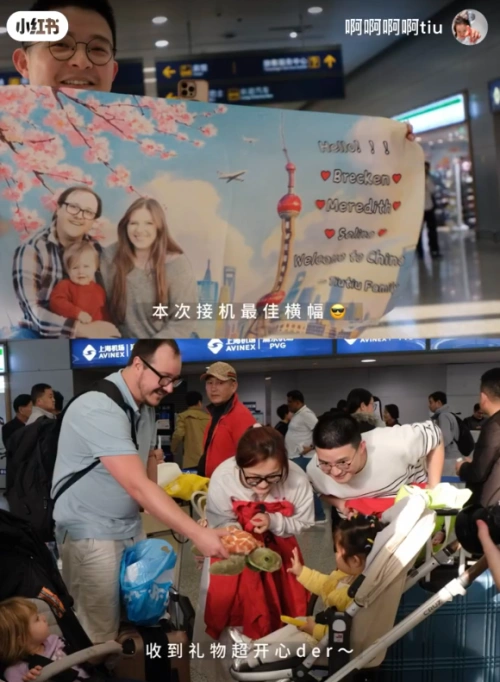
Adults with arms around each other, children holding hands. Everything felt so natural, as if life should always be like this.

The Brecken family’s story is by no means unique. When he finally tasted the soup dumplings and dumplings he had been longing for, Italian game designer Federico returned to China with his mother.
Over thirty years ago, his mother and grandmother had been here. They had roamed the bustling streets of Beijing and experienced the sights of the prosperous farmer’s market in Xi’an. They marveled at how the majestic Great Wall of Beijing was built and were curious about the craftsmanship behind the Terracotta Warriors in Xi’an.

Growing up listening to his mother’s tales of this magical trip, he became curious about China. Recently, he found old videotapes from the past, organized and posted them on Rednote, garnering many heartfelt responses from Chinese netizens.
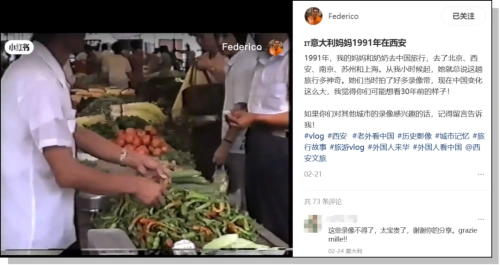
In this age of reflected images, many now reminisce about their childhoods through these videos. People look back at these images, reminiscing about the past that cannot be revisited, and recalling their carefree selves.
They pen down a series of sincere words, thanking him for his sharing and eagerly welcoming him and his mother to see present-day China, to experience the earth-shaking changes of these years. So, they set off once again.
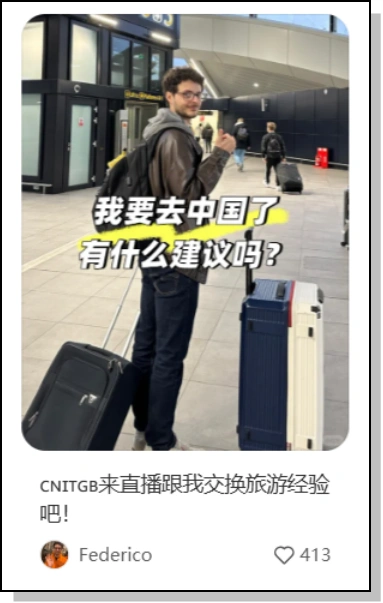
At this very moment, “Jiggly Boy,” the shaking boy, has been surrounded by the enthusiastic people of Shanghai. Many years ago, he danced a belly dance on the stands of the Timberwolves’ home court, becoming famous overnight. Many people don’t watch the NBA, don’t know his name, but remember his dance and recognize his face.
In the past, on social media overseas, he was attacked for his body, for his personal identity, and for many unexpected things. But on Rednote, his situation has improved greatly.
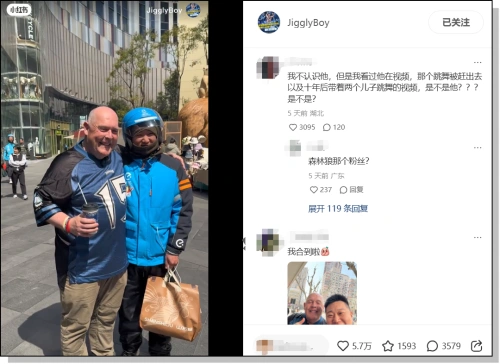
People here discuss music, cats, and many more loving and kind things. They emphasize the positive, optimistic aspects, rather than taking positions that create barriers between each other.
“They are very friendly and kind. They keep saying, ‘Come to China.’ So, we came.” Here truly did not disappoint him.
Similar to the atmosphere on Rednote, he received a warm welcome from his Chinese partners. Walking on the streets, many people were surprised to recognize him, then excitedly started dancing his classic dance as a way of greeting him.
It was like meeting an old friend after a long separation.

Professor Alex from the University of Leeds initially just wanted to take a look on Rednote to see what his students were up to, but he was quickly won over by the authentic food and restaurant recommendations, saying, “It understands my heart better than any other platform.”
Soon, he mastered the ways of Rednote on his own and began participating in this vast exchange of information. When he came across queries about the University of Leeds, he would proactively engage, indirectly contributing to the school’s content.
Not knowing where to shop in Shanghai himself, he sought advice from everyone, displaying a genuine willingness to listen to suggestions.

On his last day in China, he reluctantly recorded his final moments. A cautious Chinese netizen asked, “Are you reluctant to leave?” and received an affirmative response. The sincere interaction and her ID mirrored each other, becoming an integral part of the beauty in the world.
Indeed, that’s how it is. What people see on Rednote is not just the usual travel guides but rather authentic shares brimming with human emotions. What matters more is not the clear-cut disputes but the scattered rays of light about life. This has led everyone to step out of their information cocoons and enter each other’s real worlds.
Two months ago, people of different languages, races, and colors gathered from all directions, rebuilding a new Tower of Babel in Rednote’s virtual world. At that time, a statement from a netizen touched me deeply: “If there are truly irresistible factors that lead to our contact being lost again, we must remember the love and trust we had for each other at this moment. If there are any comments that defame each other in the future, we can firmly tell ourselves: what I see is not like that.”

Now, two months have passed, and our connection has not only remained intact but has also seen more people continuing to write their stories through actions. American blogger Diane has been learning Chinese for three years and even makes vlogs in Chinese. Recently, she obtained a ten-year tourist visa for China, preparing to spend her summer here.

Teacher Marge also wants to visit her Rednote friends in China. She finds the people here lovely, patient in helping her choose a name and meticulously explaining the meanings of each word.

Anna, a German girl raised in Denmark, has also started collecting travel advice from Chinese netizens.
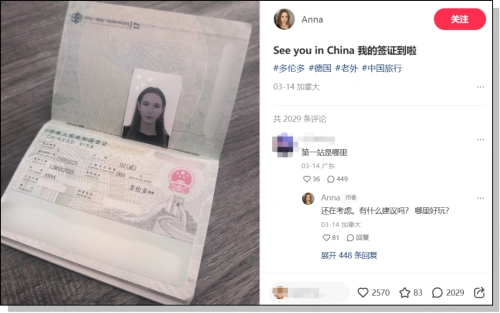
Their reasons for wanting to set off may seem different—purely for travel, perhaps a long-awaited honeymoon, or just to visit distant friends—yet what unites them is being touched by the authentic Chinese life presented on Rednote. This authenticity is leading to connections between people, heading towards new possibilities.
What is even more heartwarming is that the stories are not limited to “foreigners arriving for the first time.” Among the foreigners who flooded Rednote earlier this year, many were old friends who had been to China before. Before these trends emerged, they had already verified the friendly and inclusive nature of the culture through personal experiences.
American Mike Junior has seen the neon lights of the Oriental Pearl Tower at night and hiked the Great Wall carrying a bag that reads “Serve the People,” but what often strikes him the most is the stunning speed of the high-speed trains.
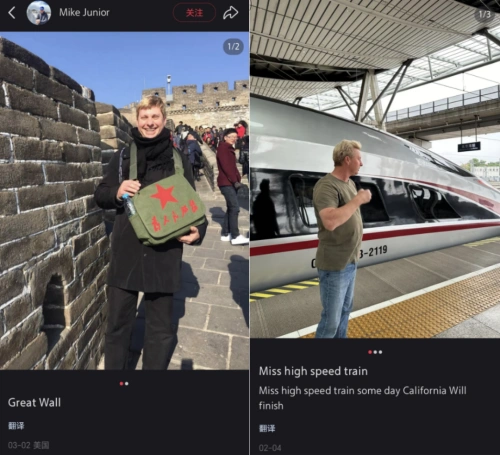
When Austrian girl Ella visited Chengdu last time, she tried on Hanfu for the first time. She posted these photos on Rednote and received a string of compliments. Everyone affectionately called her “Foreign Fairy.”
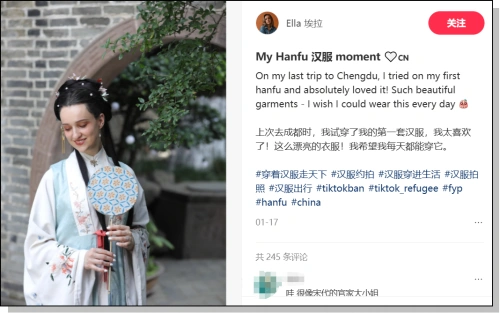
The traditional Chinese game of Mahjong has also become an important prop for cultural exchange. French friend “小猪猪18”(Rednote username) wreaked havoc at the Mahjong table in Chengdu and couldn’t stop playing.
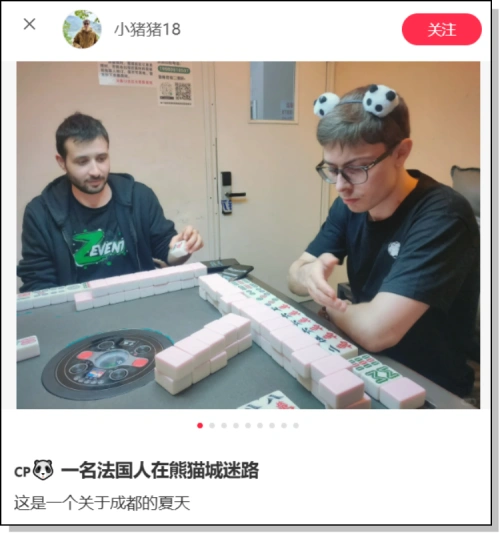
Andy Natlum rented a house in China and followed Chinese customs to celebrate the Spring Festival, writing couplets and watching the Spring Festival Gala. Foreigners are becoming more like locals.

Meanwhile, for the third time, Chilean travel blogger “飞鸽Feige” (Rednote username) chose to venture off the beaten path and set his destination for Guiyang after a 40-hour journey. He said he wanted to see more facets of China.
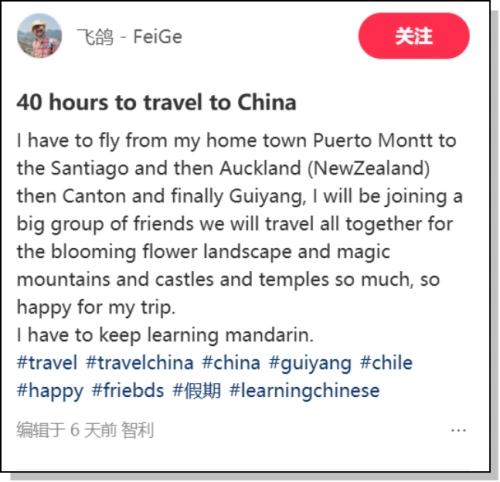
While politicians are still debating what should be restricted and what shouldn’t, ordinary people have already begun to enjoy the genuine warmth of human life. In a trance, it feels as though the world has leaped directly from the year 2000 to now, with the power struggles and confrontations of the past twenty years disappearing. The Earth is still the same global village, and we are all still envisioning a bright future.
Today, as the curiosity wave recedes, people are more focused on genuine individuals. They no longer view each other as mere “sights” to be observed but truly begin to communicate, to share the real, steady flow of life with each other.
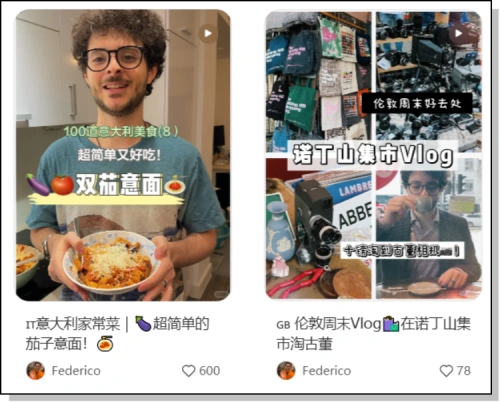
What we are witnessing is an elevation in communication. Just as we eagerly plan a trip to a certain place after stumbling upon restaurant recommendations in Guiyang, ancient building maps in Shanxi, or desiring to meet like-minded individuals, these international friends have come here for the same reasons.
What they feel on Rednote is not just the allure of a foreign culture but a resonance with real life. It is this authenticity that makes foreign friends from afar feel a sense of closeness. Jiggly Boy has a lot to say about this.
Over the past few years, he has witnessed the rise of social media and realized how their emergence has changed people’s behavior. Through online interactions, netizens gradually fail to realize they are communicating with real individuals and thus launch aggressive attacks, leading to today’s internet being filled with emotions, hostility, arguments, and stances, turning many matters into clashes between different viewpoints, especially after the introduction of algorithms.
Algorithms discovered that content filled with negative emotions, panic-inducing, and divisive tendencies is more likely to spread, leading to the rampant spread of rumors and conspiracy theories online. In “Homo Deus,” a tragic incident caused by an algorithm is mentioned. In 2016, the Burmese military and Buddhist extremists launched a large-scale ethnic violence event, killing 7,000-20,000 civilians.
After a UN investigation, it was concluded that “Facebook played a ‘determining role’ in the events – the artificial intelligence algorithms actively reinforced and promoted the content on the Facebook platform, inciting discrimination, hatred, and violence against Myanmar’s Muslim ethnic group.”
 Yuval Harari, the author of Nexus, explains how algorithms promote conspiracy theories against Myanmar’s Muslim ethnic group.
Yuval Harari, the author of Nexus, explains how algorithms promote conspiracy theories against Myanmar’s Muslim ethnic group.
However, the atmosphere that Jiggly Boy experiences on Rednote is completely different, resembling the pre-social media prevalent online ecosystem: “Just like in a theater, people of different beliefs will laugh uproariously at the same joke.” While Western social media platforms are busy amplifying biases and sparking conflicts using algorithms, Chinese netizens on Rednote are using down-to-earth expressions to authentically showcase their lives, bringing those faces blurred by the internet back into focus, embodying vivid, flesh-and-blood individuals.
“Everyone has a place, everyone has a voice, everyone can be heard and listened to. I like it when an ordinary person can share, and then we say, ‘I see you, I hear you, you are important, you’re great.’”
People showcase themselves here and understand others. Therefore, the connections being established are not between me and a group, a faction, but between me and you, between people.
This genuine, strong, and touch-filled connection is rewriting the internet fairy tale of the new era – where someone is willing to traverse great distances not just to climb the Great Wall, see the Oriental Pearl Tower, or reunite with long-lost friends, but also to not disappoint the pure and lively hearts that still exist amidst the turmoil of this era.
The post After Using Rednote, TikTok Refugees Flock to China first appeared on China Academy.
]]>The post How China Won the Soybean War Against the U.S. first appeared on China Academy.
]]> Workers air soybeans in Beian, Northeast China’s Heilongjiang province
Workers air soybeans in Beian, Northeast China’s Heilongjiang province
China is the world’s largest consumer and stockpiler of soybeans. However, its domestic soybean production is low, and the majority of its supply relies on imports. The country is the trade destination for more than 60% of the world’s soybean imports. But why has China been increasing its soybean reserves and emphasizing self-sufficiency?, Because in the past, it has long suffered at the hands of the U.S.
Before 2001, China made multiple attempts to join the WTO, but each time, the U.S. rejected its application. One of the most difficult conditions in the negotiations was that China had to sign an agricultural cooperation agreement and open its grain market to American products. The U.S. primarily exported wheat and soybeans and demanded full market access. While China attempted to negotiate a compromise, at the very least, it had to open its market to one of these products. If China refused to open either, the U.S. would block its WTO entry, as a single country’s veto could prevent accession—and in this case, that country was the United States.
After careful deliberation, China decided to open its soybean market while keeping wheat protected. The reasoning was that, although soybeans were more expensive, their yield was lower, and they were primarily used for oil production and livestock feed. Even if there were supply issues, the worst outcome would be a shortage of meat. However, wheat was a staple food, and keeping it protected ensured that China’s food security remained intact.
In 2001, China joined the WTO and upheld its agreement by opening its soybean market to the U.S. Almost immediately, an influx of American soybeans flooded the Chinese market, decimating the domestic soybean industry. American soybeans, which were genetically modified, benefited from vast black soil farmlands, leading to significantly higher yields and lower costs. On top of that, U.S. farmers received agricultural subsidies from the federal government, giving American soybeans a crushing price advantage. Even after being shipped across the ocean, the landed price of American soybeans was still 50% lower than that of Chinese soybeans.
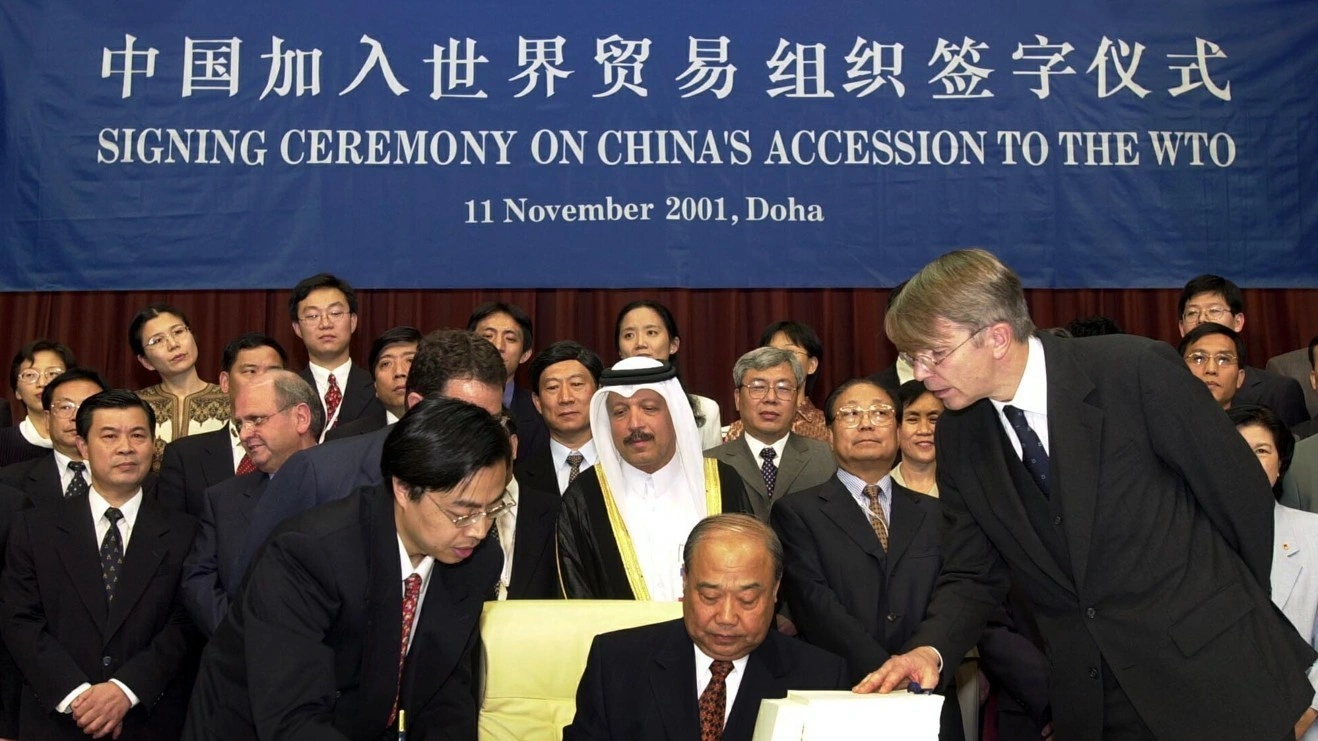 China joined the WTO in 2021
China joined the WTO in 2021
Faced with such a drastic price gap, Chinese soybean processing companies quickly stopped purchasing domestic soybeans. As domestic prices plummeted, farmers saw no incentive to continue planting, and China’s soybean production began to decline rapidly.、
By 2002, China’s soybean production had fallen drastically. By 2003, it had been reduced to a fraction of what it was before WTO accession, with nearly all domestic soybean processing companies relying on American soybeans. Then, with Chinese soybean production nearly wiped out, American grain traders made their move.
In August 2003, a month before the U.S. soybean harvest, the U.S. Department of Agriculture (USDA) suddenly announced that drought conditions would cause a significant reduction in soybean yields. Over the next four months, the USDA continued to revise its forecast downward, further reducing the expected soybean inventory.

Triggered by USDA data, global soybean prices skyrocketed from over $300 per ton to over $600 per ton—surpassing the price of Chinese soybeans. Since it takes time to grow soybeans, China couldn’t rely on domestic production to fill the gap in just a few months. However, the $600-per-ton price tag was prohibitively high, effectively doubling anticipated costs. Chinese soybean processors refused to accept such high prices and instead reduced imports, relying on their existing stockpiles while hoping that prices would eventually stabilize. There were also rumors that the U.S. government might intervene to curb the soaring soybean prices, so many companies chose to wait. However, China’s soybean production was severely insufficient, and the U.S. controlled the global soybean export market. It wasn’t a simple matter of refusing to buy.
By March 2004, the USDA announced that it would not increase soybean production. This sent global soybean prices soaring again, rapidly climbing to over $750 per ton, with no signs of stopping. At this point, panic set in among Chinese soybean companies. After holding out for six months, their reserves had been depleted, and the USDA had made it clear there would be no intervention. Seeing no end to the price increases, Chinese soybean processors scrambled to sign massive long-term procurement contracts with American grain traders. Once China’s soybean companies had locked themselves into these high-priced contracts, U.S. grain traders tightened their grip. Since other countries’ purchases were relatively small, their primary target was China.
After securing these high-value contracts, the USDA suddenly released two major announcements. First, the U.S. government, out of concern for domestic needs, would implement policies to encourage soybean production. Second, previous reports about soybean shortages were inaccurate due to statistical errors. There was actually no significant shortage, and there was no need for panic buying. While the USDA claimed it had penalized staff internally for the errors, the impact of these announcements was immediate—within a month, soybean prices collapsed from $750 per ton to about $300 per ton, returning to pre-crisis levels.
Chinese soybean companies were left in shock. If they followed through with the contracts, they would suffer massive losses. If they defaulted, they would have to pay exorbitant penalties. After weighing their options, many chose to default, as even after paying fines, the losses were still lower than purchasing soybeans at inflated prices.
In response, the four major American grain traders jointly sued Chinese companies for breach of contract, demanding over $5.4 billion in compensation. If China refused to pay, the U.S. threatened a global soybean embargo and a lawsuit in the WTO. The fallout was devastating—within a year, nearly all of China’s soybean processing companies had gone bankrupt. Of the 1,000 soybean processors in China in 2003, only about 90 survived by the end of 2004, 64 of which were controlled by foreign investors. China’s independent soybean processors had been virtually wiped out, with only a handful of state-owned enterprises left standing.
The damage extended beyond processors to farmers. By late 2003, soybean prices had surged past $540 per ton, making soybean farming highly profitable. By March 2004, prices soared to $750, prompting many farmers to plant soybeans in April. But after the USDA’s announcements, prices plummeted to $300 per ton by June. At that point, it was too late—farmers had already planted their crops and had no alternatives. When the soybeans were harvested in August, prices remained stuck at $300, causing massive losses. Many farmers lost years of savings and swore never to plant soybeans again.
By 2004, American grain traders had monopolized China’s soybean industry from production to processing. To prevent further manipulation, China had to take action. However, U.S. grain traders controlled both the cheapest production and the largest supply, giving them absolute pricing power.
In 2004, when U.S. traders drove soybean prices to historic lows, attempting to wipe out Chinese farmers completely, the Chinese government stepped in. State-owned China Grain Reserves Group also known as Sinograin, began stockpiling vast amounts of soybeans—buying both domestic and imported soybeans at low prices and filling its storage facilities as quickly as possible.

In 2005, Sinograin continued accumulating soybeans. It conducted this stockpiling operation in secrecy, and to this day, no one knows exactly how many soybeans Sinograin stored during 2004–2005. If American grain traders had maintained the status quo, China’s reserves would have remained unused. However, after gaining full control of China’s soybean industry, U.S. traders only stayed quiet for a year before attempting to repeat their old tactics.
In 2006, citing natural disasters and reduced soybean yields, U.S. grain traders started restricting soybean exports and driving up prices. But unlike in 2004, this time China had reserves. When the price reached an unacceptable level, Sinograin began releasing its stockpiles in a controlled manner, selling soybeans at slightly below market price every ten days. Despite Sinograin’s moves, U.S. traders continued to push prices upward. In response, China increased the frequency of its releases—starting with ten-day intervals, then weekly, and eventually every three days. At the time, the U.S. traders remained unfazed, continuing to limit exports to sustain high prices. This standoff persisted until the 2008 global financial crisis, which devastated financial markets across Europe and the U.S., dragging the global grain market down with it. Only then did soybean prices finally collapse.
Interestingly, just before the 2008 Beijing Olympics, Sinograin announced that China’s soybean reserves had become excessive, with many soybeans in storage having exceeded their shelf life and becoming unsuitable for consumption. The corporation sought partnerships with livestock businesses to offload the stockpile as animal feed. This announcement further drove down soybean prices.
By the end of 2008, soybean prices had plummeted to a historic low, and Sinograin took advantage of the situation by massively restocking its warehouses, replenishing all the reserves it had sold at high prices over the previous two years. The corporation also continued expanding its storage capacity, ensuring that China could maintain a robust soybean reserve. The exact quantity of soybeans held by Sinograin remains a state secret, but independent estimates from various organizations suggest an astronomically high figure.
In 2020, amid the COVID-19 pandemic, global grain production declined, and eleven countries and regions suspended soybean exports to China. Yet, China’s soybean supply remained unshaken, thanks to its vast reserves.
When China first joined the WTO, the U.S. seemed to suffer a “natural disaster” every few years, causing massive soybean shortages. However, after China built extensive soybean storage facilities, these disasters just disappeared, and U.S. soybean production became remarkably stable—unaffected by floods or droughts. Who would have thought that Sinograin’s soybean reserves could control U.S. weather?
In recent years, China has not only expanded its soybean reserves but has also boosted its domestic production capacity. For example, intercropping soybeans with corn at optimal spacing has maximized land use and increased
crop yields. According to official data, China’s grain production has exceeded 650 million tons for nine consecutive years, with soybean output stable at over 20 million tons.
 This model refers to the practice of alternating the planting of soybeans and corn on the same field in a strip pattern or at a fixed row spacing.
This model refers to the practice of alternating the planting of soybeans and corn on the same field in a strip pattern or at a fixed row spacing.
Compared to 20 years ago, China has reversed the power dynamics in agricultural trade with the U.S. If Trump continues to seek a Trade War II against China, it might not be China that should be worried—but American grain traders and soybean farmers.
The post How China Won the Soybean War Against the U.S. first appeared on China Academy.
]]>The post Are Highly Intelligent Humans Still Superior to AI? first appeared on China Academy.
]]>AI and High IQ Cognitive Contest
The rapid evolution of artificial intelligence (AI) systems has ignited debates about their equivalence to—or superiority over—human intelligence, particularly when benchmarked against individuals with high intelligence quotients (IQ). While high IQ (defined as scores ≥130 on standardised tests like the Stanford-Binet) represents exceptional human cognitive abilities in pattern recognition, abstract reasoning, and problem-solving, modern AI systems excel in data processing, algorithmic optimisation, and task-specific execution. This article employs empirical data, neuroscientific research, and technical analyses to compare these two forms of “intelligence,” emphasising their distinct operational frameworks, ethical considerations, and societal impacts.
Cognitive Architecture: Fundamental Divergences
Computational Foundations
AI systems, such as deep neural networks, operate through layered mathematical transformations. For instance, GPT-4 utilises 1.76 trillion parameters, ¹ enabling it to process 45 000 words per minute—a throughput 57 000× faster than the average human reading speed. ² By contrast, high-IQ cognition relies on biological neural networks, with the human brain containing approximately 86 billion neurons connected via 100 trillion synapses. ³
Key Metric:
– AI: 3.14 exaflops. ⁴
– Human Brain: Estimated 1 exaflop equivalent. ⁵
Energy Efficiency
High-IQ brains consume ~20% of basal metabolic rate, ⁶ while training GPT-4 required 50 GWh (equivalent to €760 million at the European Central Bank’s exchange rate of 1:7.736), ⁷ enough to power 12 500 EU households annually. ⁸
Implication: Biological systems remain vastly more energy-efficient per computational unit.
Problem-Solving: Specialisation vs. Adaptability
Task-Specific Dominance
AI outperforms humans in bounded domains:
– Chess: Stockfish 16 evaluates 70 million positions/second⁹ vs. Magnus Carlsen’s 5–6 positional evaluations/second. ¹⁰
– Medical Diagnostics: DeepMind’s AlphaFold 2 predicts protein structures with 0.16 Å accuracy, ¹¹ surpassing human crystallographers’ 1.5 Å average error margin. ¹²
Generalised Reasoning
High-IQ individuals retain superiority in open-ended scenarios requiring transfer learning:
– Analogical Reasoning: 98% of humans solve novel metaphor-based problems, while GPT-4 achieves 72% accuracy. ¹³
– Moral Judgement: Humans apply context-sensitive ethical frameworks, whereas AI systems lack intrinsic moral reasoning. ¹⁴
Case Study:
In the 2023 International Linguistics Olympiad, human gold medallists solved 89% of novel decipherment puzzles, while fine-tuned LLMs achieved 61% accuracy. ¹⁵
Regional Cognitive Trends and Governance
Standardised IQ studies suggest regional variations in cognitive testing performance. A 2022 meta-analysis ¹⁶ reported average IQ scores in East Asia (including China, Japan, and South Korea) ranging between 105–109 on the Wechsler scale, compared to Western averages of 97–101. These figures derive from culturally adapted tests administered by the International Society for Intelligence Research. ¹⁷ Notably, China’s 2021 national education budget reached ¥5.67 trillion (€730 billion), funding 12.3 million STEM graduates annually, ¹⁸ while the OECD’s PISA 2022 rankings placed Shanghai students 1st in mathematics. ¹⁹
Political Leadership Selection Mechanisms:
China’s civil service examinations emphasise rigorous cognitive testing. The 2023 National Public Service Exam attracted 2.6 million applicants for 37 100 positions. ²⁰ China’s leadership pipeline prioritises technical expertise ²¹ and meritocratic advancement. ²² By contrast, 44% of US Congress members hold law degrees, ²³ with electoral success often tied to campaign finance and public speaking. ²⁴
Cognitive Velocity:
High-IQ individuals exhibit quantifiable advantages in rapid information synthesis:
– Neural Efficiency: fMRI studies show 18% faster prefrontal cortex activation during problem-solving among IQ ≥130 cohorts. ²⁵
– Working Memory: High-IQ subjects retain 9.2 items in working memory vs. 6.5 for average. ²⁶
Learning Mechanisms: Training vs. Cognitive Plasticity
AI: Supervised and Reinforcement Learning
– Data Dependency: GPT-4 trained on 570 GB text. ²⁷
– Catastrophic Forgetting: Retraining on new data degrades prior knowledge by 12–18%. ²⁸
Human Neuroplasticity
– Lifetime Learning: High-IQ brains maintain synaptic plasticity, with dendritic spine density 23% above population mean. ²⁹
– Cross-Domain Transfer: Multilingual individuals show 19% faster algorithmic learning. ³⁰
Ethical and Societal Considerations
Bias and Fairness
– AI: Image generators exhibit racial bias, misclassifying 34% of darker-skinned faces vs. 12% for lighter tones. ³¹
– Human: Implicit Association Tests reveal 68% of high-IQ individuals retain demographic biases. ³²
Governance Frameworks
– China: 2023 AI Governance Rules mandate algorithmic transparency. ³³
– EU: AI Act (2024) prohibits social scoring and emotion recognition in workplaces. ³⁴
Regulatory Gap: Only 12% of nations have AI-specific laws vs. 89% with IQ anti-discrimination statutes. ³⁵
Urbanisation and Trade Dynamics
China’s urbanisation rate reached 66.16% by Q3 2023,³⁶ driving state investments of ¥5.88 trillion (approx. €760 billion) in AI-integrated infrastructure. ³⁷ Concurrently, US-China trade volumes grew 6.3% year-on-year to $690.6 billion in 2022, ³⁸ highlighting interdependencies that complicate AI decoupling efforts.
Future Trajectories: Synergy or Competition?
Augmented Intelligence
Hybrid systems leveraging both forms show promise:
– Medical Diagnostics: AI-assisted radiologists improve tumour detection rates from 78% to 94%. ³⁹
– Scientific Research: AlphaFold + human crystallographers reduced protein analysis time from 6 months to 2 weeks. ⁴⁰
Existential Risks
– AI Misalignment: 18% probability of “severe misuse” by 2030. ⁴¹
– Cognitive Inequality: AI could widen gaps between high-IQ and average populations in labour markets. ⁴²
Conclusion
AI and high IQ represent complementary paradigms: one excels in scale and speed, the other in adaptability and ethical nuance. Current evidence refutes notions of supremacy, instead advocating for integrated systems that harness their respective strengths. Policymakers must prioritise regulatory parity, ensuring neither becomes a vector for societal inequity.
The post Are Highly Intelligent Humans Still Superior to AI? first appeared on China Academy.
]]>The post Hollywood Treats US Viewers as Fools, Chinese Screenwriter Lashes Out first appeared on China Academy.
]]>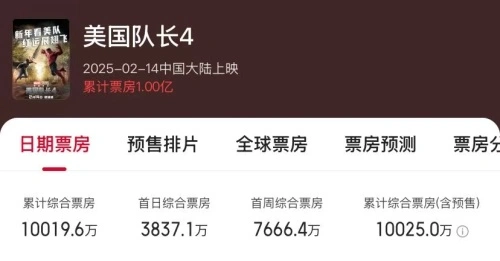 Captain America 4 Chinese Mainland Box Office
Captain America 4 Chinese Mainland Box Office
Currently, box office software in mainland China predicts that the final box office revenue for this film will only be 111 million yuan. Despite receiving ratings from over 38,000 users on Douban (a Chinese movie review website), the film has only received a score of 5.2. It is the worst-reviewed film in the “Captain America” series and the worst-performing Marvel movie in mainland China apart from “Captain Marvel 2.”
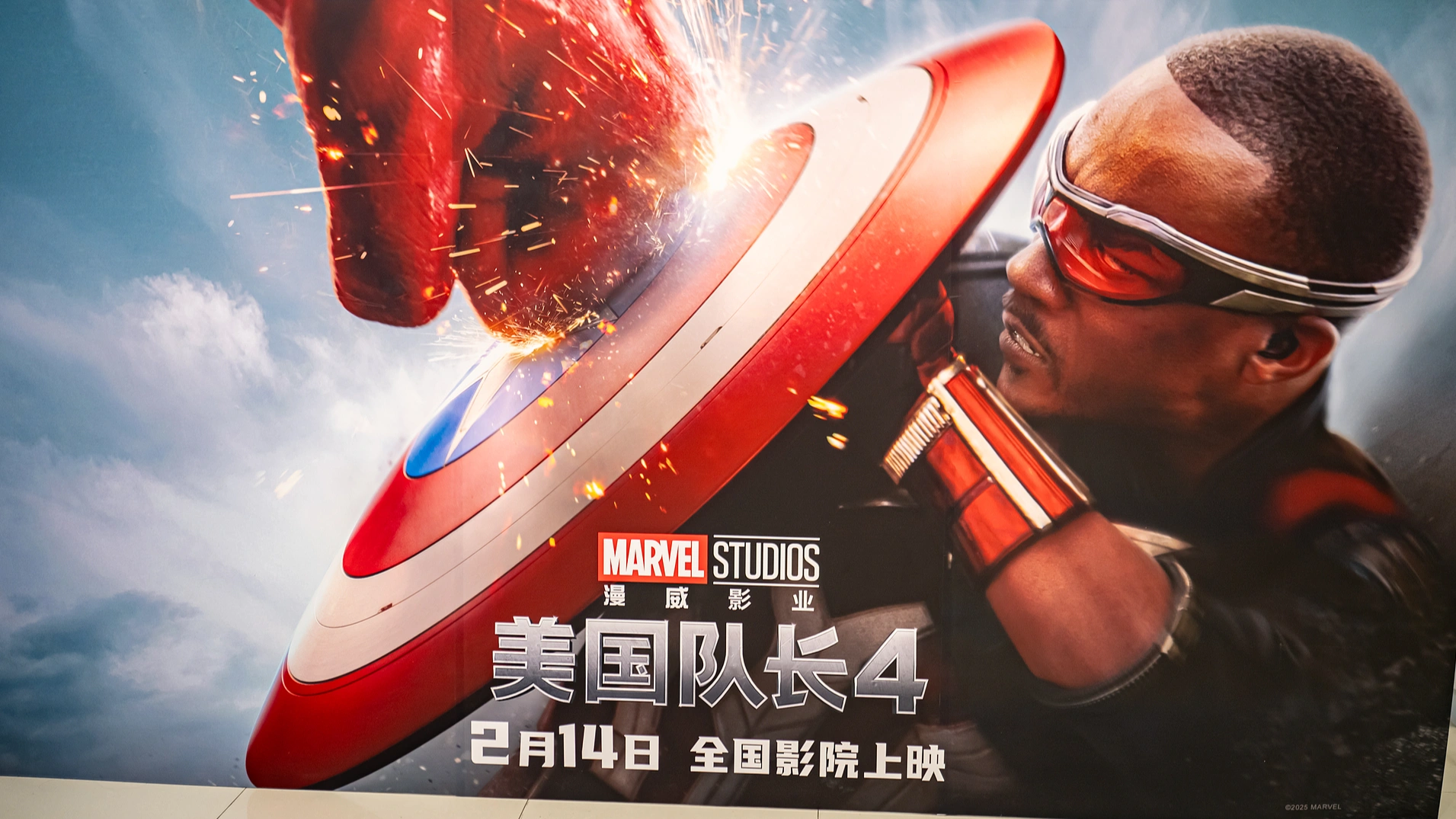
Marvel movies used to be highly anticipated by countless fans even before their release, and they used to dominate the box office. In 2018, “Avengers: Infinity War” grossed as high as 2.39 billion yuan in mainland China. The following year, its sequel “Avengers: Endgame” even raked in 4.238 billion yuan, becoming the highest-grossing foreign film in Chinese cinematic history. While Marvel movies of the past were magnificent, they now face a dismal situation. This also reflects the state of Hollywood movies, and even American influence in China.
In the United States, many aspects of culture are worth learning from, with one of the most prominent being its spirit of introspection. America is not afraid to face problems as evidenced throughout its history. McCarthyism, the assassinations of Martin Luther King Jr. and John F. Kennedy, the Vietnam War – each crisis has sparked reflection within American cultural circles, giving rise to outstanding works, shaping trends, and propelling societal advancement. Crucial to this has been the cultural influence of the American left. It has endowed America with the capacity for self-examination, enabling a clear-sighted understanding of itself and the world.
Scripts crafted by a group of unnamed American Communist Party members were adapted into films, including “Roman Holiday,” “Spartacus,” “High Noon,” “The Bridge on the River Kwai,” and more. Woody Allen also collaborated with former American Communist Party members post-release from prison. These remarkable works have contributed to Hollywood’s success, upholding American culture.
However, since the turn of the century, there has been a significant transformation in the left-wing cultural forces in America, leading to fragmentation. Some have become the mainstay of the LGBT movement, delving into identity politics. While actions against racial discrimination and environmental advocacy continue, the once potent forces advocating against imperialism, war, and progress have faced diverse opposition worldwide post the 9/11 incident. Politically, America has labeled them all as terrorism. Culturally, the formerly rational, progressive, lucid, and self-regulating cultural forces have collapsed, disintegrated, and even vanished, lacking reflection and serious scrutiny. America has never lost its introspective ability as it has today. Currently, Western civilization, including Christian civilization, is grappling with numerous issues and even crises, yet America remains oblivious, lacking introspection, and plunging into political hysteria and cultural self-numbing.
Present-day America is culturally feeble, with its cultural circles focusing on what? What does its film industry portray? One would notice that America is no longer at the forefront of global popular culture, no longer the nation that raises questions first and contemplates deeply. It seems to be solely focused on profit, devoid of ambition in culture, blindly following the crowd, aimlessly present without purpose or direction.
Why is Hollywood failing? In fact, Hollywood is not entirely failing on a global scale; it’s just that its influence in the Chinese market is not as strong as before. Why is this? Hollywood no longer provides us with dreams; it is no longer a beacon, and this is crucial. “Love and courage” have always been Hollywood’s timeless themes. But where is its love manifested today? Where is the courage? Supporting Palestine, the American cultural sphere has not continued to steer society towards significant change. While stars like Cate Blanchett have spoken out, it is far from sufficient. Hollywood is no longer a formidable political force; the so-called diversity has overwhelmed justice, leaving students largely isolated and helpless. Jewish capital controls the media and Hollywood.
Today, Hollywood’s voice is feeble. They can easily organize hundreds of thousands to march for the legalization of same-sex marriage but cannot change anything for the children in Gaza. Powerless in the face of reality and lacking the courage to confront it, this is Hollywood’s weakest moment. So, can we still rely on the “love and courage” it preaches?
The Chinese might be one of the first groups in the world to realize this. We hope for a new interpretation about the direction the world should take. The Chinese have proposed a “community of shared future for mankind,” a theme reflected in “The Wandering Earth.” If Hollywood does not agree, then present your own. After all, the old narratives of arrogance, zero-sum games, and the Noah’s Ark story from Christian civilization have been preached for centuries. Are there any new ideas now? Not really; the same old ideas are being repeated. While the world undergoes significant changes, Hollywood’s transformation remains minimal.
The post Hollywood Treats US Viewers as Fools, Chinese Screenwriter Lashes Out first appeared on China Academy.
]]>The post Mexicans Unite Now More Than Ever Against US Sanctions first appeared on China Academy.
]]>The post Mexicans Unite Now More Than Ever Against US Sanctions first appeared on China Academy.
]]>The post Xi’s Meeting With China’s Top Entrepreneurs, Explained first appeared on China Academy.
]]>The post Xi’s Meeting With China’s Top Entrepreneurs, Explained first appeared on China Academy.
]]>The post China’s Ukraine Peace Plan: A Solution from Day One first appeared on China Academy.
]]>Regardless, China’s “principled neutrality” has played a crucial role in preventing the conflict from spilling beyond Europe and even spiraling into a nuclear confrontation towards World War III.
Beyond China’s vast economic power and military potential, the key to this stabilizing influence lies in its “principled” and “impartial” neutrality. Unlike the “pure,” “permanent,” or passive neutrality seen in European history (e.g., Switzerland), China does have its opinion and preference regarding the nature of the Ukraine war, particularly its origin, which is NATO expansion.
The East: NATO’s Fatal Attraction
From the beginning, Russia’s “special military operation” in Ukraine has been framed in the Anglosphere as an “unprovoked attack.” From China’s perspective, however, Russia’s use of force was the inevitable consequence of NATO’s relentless eastward expansion. Since the end of the Cold War, there have been five waves of such expansions to the east despite strong warnings from Moscow.
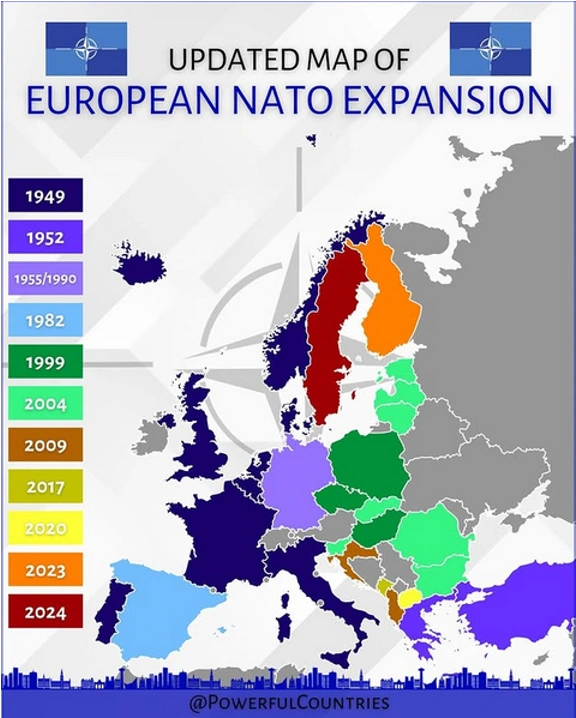
China is not alone in this assessment. In 1997, George Kennan, the chief architect of America’s Cold War containment strategy, warned that NATO expansion “would be the most fateful error of American policy in the entire post-Cold War era.” Former U.S. Ambassador to the Soviet Union Jack Matlock echoed Kennan’s concerns, calling the expansion a “misguided” decision that “may well go down in history as the most profound strategic blunder….” Bill Clinton’s Secretary of Defense William Perry went as far as to resign because he disagreed with Clinton’s “rosier scenario” about NATO expansion. Henry Kissinger, too, cautioned that Ukraine’s survival and thriving must be based on its neutrality as a “bridge,” not a battlefield, between Russia and the West.

Despite these sober warnings from some of the West’s most seasoned strategists, their insights were largely dismissed by the liberal interventionists and neoconservatives who shaped post-Cold War foreign policy. The world now is living with the blowback of the West’s arrogance and ignorance.
China’s “Constructive” Neutrality: Pragmatism, Humanitarianism, and Political Realism
Maintaining a neutral and impartial stance on the Ukraine war in a deeply divided world is no easy task. Yet China chose the hard way. Its position rests on several core principles: upholding the UN’s commitment to sovereignty and territorial integrity, supporting all efforts toward a peaceful resolution of the crisis, and advocating for common, comprehensive, and sustainable security for all, not just a few. China has also consistently emphasized the need to protect civilian lives and property, reframed from providing weapons to the warring parties, and urged restraint to prevent further escalation.
China’s neutrality in the Ukraine conflict, therefore, is not passive or indifferent but rather a blend of pragmatism, humanitarianism, and political realism. Unlike the European tradition of neutrality as an end in itself or neutrality for neutrality’s sake, China’s approach is one of “constructive engagement,” as described by Zhao Huasheng, a prominent Russologist at Fudan University in Shanghai. Reflecting this commitment, China’s special envoy for Eurasian affairs, Li Hui, conducted four rounds of shuttle diplomacy between May 2023 and July 2024 (May 2023; March, May, and July 2004), seeking a political resolution to the ongoing conflict.
Normal Relationship in Abnormal Times
China’s principled neutrality in the Ukraine war is grounded in its “normal ties”—or balanced and stable relations—with both Ukraine and Russia. At a minimum, both Russia and Ukraine are China’s friends. It is immoral, or amoral, for China to support one at the expense of the other.
For years, Ukraine has been a vital economic partner for China. Until 2022, Ukraine served as the most significant hub for China’s expansive Belt and Road Initiative (BRI) in Central and Eastern Europe. Beyond this, Ukraine also played a critical role in China’s military modernization in the post-Cold War era.
At the height of the 2013 Crimea crisis, China extended an unprecedented $8-billion economic package to Ukraine—the largest offer from outside Europe. An indicator of this normal, and strong partnership with China is Ukraine’s continuous hold on its one-China policy, despite increasing Western support for Taiwan’s independence. During his visit to China in May 2024, Ukraine’s then-FM Kuleba went as far as to say, “China is a great country, and Ukraine and China are not only strategic partners but also important economic and trade partners.”
In the case of China-Russia relations, the West often portrays China as Russia’s “chief enabler” in the Ukraine war. But such a characterization distorts the nature of the China-Russia relationship.

The current Sino-Russian “comprehensive strategic partnership” is essentially a normal relationship after the 10-year Sino-Soviet alliance between 1949 and 1959 and 30-year adversarial relations from 1960 to 1989. A key element of this normal relationship is the absence of ideology, which exaggerated, unnecessarily, the “love-hate” oscillation between 1949 and 1989. Now the two sides treat each other as who they are rather than what they wish to see each other.
In the strategic domain, the China-Russian partnership is not an alliance because it does not have an interlocking mechanism similar to NATO’s “Article 5” that automatically commits one side to the other in times of war. Instead, this normalcy provides two large powers with freedom of action and strategic depth after the “best” and “worst” times in the past.
While China and Russia’s relationship is not without challenges, their differences are usually managed through dialogue and compromise, rather than being politicized. Largely because of this, the current partnership relationship is perhaps the most equal, most stable, and least harmful form of interaction between the two powers. This is very different from much of the 19th and 20th centuries when Russia forcefully inserted itself into a weak and chaotic China by either Czarist imperialism or by Bolshevik’s revolutionary idealism and Stalin’s brutal realism.
Tales of Russia’s Two Borders
A cornerstone of such a normal and stable relationship between Moscow and Beijing is the final resolution of the centuries-long border issue—a stark contrast to Russia’s unsettling and conflict-ridden western borders.
Both Gorbachev and Yeltsin began their presidencies with sweeping pro-Western policies. The initial enthusiasm of Gorbamania and Yeltsin’s “shock therapy,” however, quickly soured into a state of “cold peace.” This deterioration was largely driven by NATO’s relentless eastward expansion, despite earlier Western assurances of “not one inch” moving eastward. As a result, Russia’s “not-so-quiet” western front has remained volatile, ultimately culminating in the largest and most intense conventional war in Europe since World War II with the potential of escalating into World War III, or even nuclear conflict.
In contrast to its romantic and often tragic interactions with the West in the post-Soviet decades, Russia’s relationship with its eastern neighbor, China, has been far more pragmatic and uneventful. It took 22 years (1982–2004) for both sides to fully normalize relations and reach a settlement on the border issues. A major step in this process was the formation of the Shanghai-Five (China, Russia, Kazakhstan, Kyrgyzstan, and Tajikistan) in 1996, which institutionalized demilitarization, confidence-building measures, border demarcation, and long-term stability. The once most heavily militarized frontiers of the Cold War are now a zone of stability and thriving cross-border trade, cultural exchange, and social interaction.
The current strategic partnership relations between China and Russia, therefore, have strong internal dynamics, and institutionalized channels of communication and management. Both sides benefited enormously from this normalcy in bilateral interactions.
Had the West pursued a similar pragmatic approach with Russia regarding border disputes, as China did, the devastating loss of hundreds of thousands of Ukrainian and Russian lives might have been averted.
“The Ukrainian conflict should never have happened, and would not have happened if I were President… But as I have made very clear for quite some time, this could now end up being World War III,” declared presidential candidate Donald Trump back in September 2022. In the 28 months leading up to his second presidency (Jan. 20, 2025), tens of thousands more Ukrainians and Russians perished in the largest conventional war in Europe since World War II.

While US President Donald Trump is rushing to undo his predecessor’s war, China remains steadfast in its posture of principled neutrality not just for ending the bloody war but is poised to shape the postwar settlement into a more just and durable peace in Europe and beyond.
The post China’s Ukraine Peace Plan: A Solution from Day One first appeared on China Academy.
]]>The post I Don’t See Manufacturing Returning to the U.S. first appeared on China Academy.
]]>The post I Don’t See Manufacturing Returning to the U.S. first appeared on China Academy.
]]>